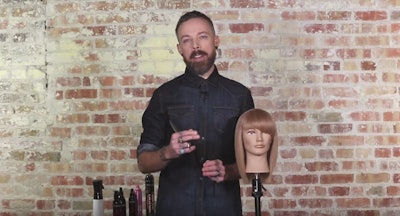
The way a haircut is sectioned prior to cutting is like a roadmap for the style. Knowing the differences between vertical and horizontal cutting patterns will ensure predictable results. Andrew Carruthers, Director of Education for Sam Villa, explains the difference in the video below:
“The main difference between a vertical and horizontal cutting pattern is how the weight is distributed and how visual the cutting line is,” explains Carruthers.
Vertical: When a typical vertical section is elevated 90° and cut straight across, it falls with a soft edge because the curve of the head naturally graduates the ends so they fall softly and blend. If that same section is point cut with peaks and valleys, as those peaks and valleys fall they too soften with the change in elevation.
Horizontal: For more weight and visual impact, use horizontal sections. When a horizontal section is elevated 90° and point cut with peaks and valleys, the section falls at the same angle as it was cut, leaving more mass and a less blended, more graphic line.
“Try something new this week - really think about the results you want before sectioning and see if vertical versus horizontal sectioning can make an impact on your work,” adds Carruthers.











